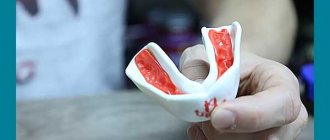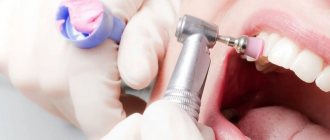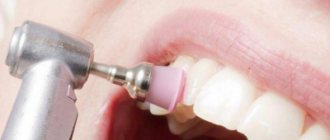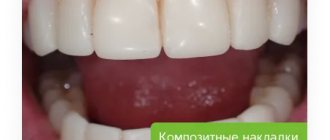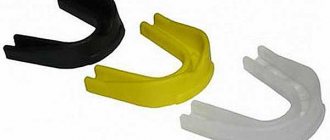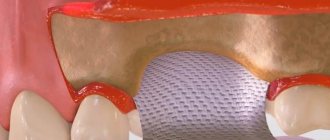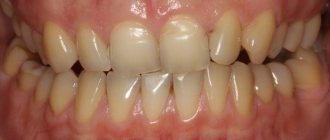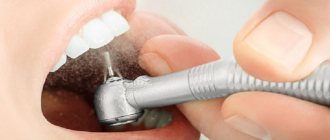Dentistry not only helps in restoring teeth, but also solves problems associated with soft tissues in the mouth. For example, when the space between the lips, teeth and gums is small. In this case, any movement of the mouth, smile, chewing process, speech, causes severe tension in the muscles and ligaments. Which leads to micro-tears and injury to the gums. And, as a result, to the appearance of problems with teeth and periodontal disease.
Vestibuloplasty in dentistry is a simple procedure for moving muscle tissue and ligaments in the oral cavity to reduce gum tension. Translated from Latin, “vestibulum” means “vestibule” - that very space between the gums and lips. The operation helps prevent such a dangerous disease as gum recession. And returns the smile to an aesthetic appearance.
It is quite difficult to independently diagnose a shallow vestibule of the mouth: discomfort in the oral cavity appears after the gums have receded. When the roots of the teeth are exposed, sensitivity to temperature changes increases. The reason for the reduction of space in front of the teeth, and the indication for the vestibuloplasty procedure, can be trauma. For example, a burn or permanent mechanical damage due to improper brushing of teeth. There are also congenital pathologies that require surgical correction.
Indications
As a rule, vestibuloplasty is prescribed before implantation, prosthetics and orthodontic treatment.
Installation of a removable denture, especially with complete edentia, is carried out only on healthy gums. Displacement or deficiency of the periodontium leads to premature wear of the orthopedic structure and injury to the mucous membrane. The vestibuloplasty procedure helps solve this problem.
Similar logic applies to the implantation process. It makes sense to implant a titanium rod only into healthy oral tissues with good blood circulation. Then the expensive structure will last a very long time. And it will become a complete replacement for a natural tooth. Both functionally and aesthetically. In this case, vestibuloplasty is indicated for successful fusion of the implant with the jawbone.
Malocclusion and problems with diction can also be associated with a small vestibule. Timely adjustment of the intraoral muscles will relieve discomfort and help achieve good results during orthodontic treatment.
Vestibuloplasty also helps eliminate external defects (unaesthetic smile, inverted lip, etc.). The sooner the patient contacts the dentist, the easier and faster the defect can be corrected. With age, the defect intensifies and becomes the cause of pathological diseases (periodontitis, periodontal disease, gum recession).
What is vestibuloplasty?
Vestibuloplasty is an operation performed to deepen the space when its size is insufficient between the outer side of the teeth and gums and the inner side of the lips and cheeks. Normally, the depth of this space in children is 4-8 mm, and after 14 years this distance should be at least 10 mm. The small size of the vestibule of the oral cavity can lead to problems of a dental and speech therapy nature, as well as cause difficulties in prosthetics or orthodontic treatment.
Possible consequences of small sizes of the vestibule of the oral cavity:
— Formation of malocclusion — Underdevelopment of the upper jaw — Excessive dental mobility — Dentofacial deformities — Speech therapy deviations
— Gum recession — Inflammatory processes of the mucous membrane of the gums — Formation of periodontal canals — Exposure of the necks and roots of teeth — Periodontal diseases – periodontitis, periodontal disease, gingivitis
The essence of vestibuloplasty is to move soft tissues and muscles in the mouth to expand the area where the gums are attached.
Contraindications
Restrictions on the operation are conventionally divided into temporary and absolute. In the first case, vestibuloplasty will be performed only after the restrictions have been eliminated. These include:
- The presence of inflammatory processes in the oral cavity.
- Colds and other respiratory diseases.
- A large percentage of teeth affected by caries.
- Sinusitis. In this case, only vestibuloplasty of the lower jaw is possible, after eliminating the acute stage of the disease.
The procedure is prohibited in case of intolerance to anesthesia, blood diseases, osteomyelitis of the jaw bone, or a predisposition to the formation of keloid scars. And also in the presence of mental illness.
Using laser in vestibuloplasty
Laser vestibuloplasty is the most innovative and gentlest procedure. The use of this technology allows you to clearly plan and organize the operation. The advantages of this method include:
- fast recovery;
- minimal damage to nerve endings;
- the ability to make a precise cut without bleeding;
- allows you to avoid tooth enamel sensitivity and tissue burns;
- eliminates the risk of infection;
- improves the fit of contacting tissues;
- prevents the development of the inflammatory process;
- has a stimulating effect on the process of tissue restoration;
- does not lead to scarring.
The medical center provides treatment for all types of dental diseases. You can make an appointment with a doctor by phone. At the appointment, the doctor will conduct an examination, diagnosis and give advice on further treatment of the identified pathologies.
Preparation for the procedure
Vestibuloplasty requires preliminary preparation. 2-3 days before surgery, the patient adheres to the recommended diet so as not to damage the mucous membrane. Immediately before the operation, 5-6 hours, you should not eat solid or tough foods. If the patient regularly takes medications, especially painkillers, it is necessary to inform the doctor in advance.
The initial stage in vestibuloplasty is hardware examination and diagnosis. Depending on the clinical situation, the doctor performs an X-ray examination or takes an image using a computed tomograph. At EspaDent clinics, for diagnostics, our specialists use a modern dental 3D tomograph Orthophos SL 3D, which takes three-dimensional, layer-by-layer images of both jaws. Accurate data helps determine the optimal treatment for each case.
Before the operation, the doctor performs professional oral hygiene. Cleans teeth from soft and hard plaque.
Symptoms
The main signs that require consulting a doctor and performing vestibuloplasty surgery are:
- deviations from the norm for the depth of the vestibule of the oral cavity (up to 5 or more than 10 millimeters);
- Excessive tension is detected at the site of the periodontal junction, making it difficult to open the mouth, eat, and speech disorders;
- increased sensitivity of incisors;
- bleeding, inflammation of the gums;
- deformations of the dentofacial apparatus;
- short bridle;
- the necks of the teeth are exposed;
- diction violations.
Operation procedure
The vestibuloplasty procedure consists of three stages:
- Use of anesthetic. As a rule, local anesthesia (freezing effect) is used. In some cases, sedation is possible - inhaling a mixture of nitrogen and oxygen through a mask. This type of pain reliever calms, relaxes and lowers the pain threshold. It has no side effects, so it is often used in children's treatment.
- The surface of the gums is treated with a disinfectant. Then the doctor makes incisions and adjusts the position of the oral muscles and ligaments.
- The vestibuloplasty procedure ends with suturing.
Additionally, the dentist fixes a bandage with antiseptics and medications on the seams. After the operation, the patient is given recommendations for oral care.
What complications can there be?
Vestibuloplasty is considered a relatively simple operation, which is practically not accompanied by serious complications. However, they cannot be excluded, especially if the patient neglects the doctor’s recommendations during the rehabilitation period. Ideally, consequences such as tissue bleeding, swelling and pain reach their peak on the second day after surgery, then begin to subside. Sometimes, negligence on the part of the patient can lead to the formation of scars, purulent inflammations and fistulas, and relapse of the disease (the probability of complications is only 0.1 percent).
“I needed vestibuloplasty in order to properly fix the prosthesis; there was not enough space. The procedure was very difficult for me, although there were no special complications, but the rehabilitation period was extremely long and protracted. The discomfort continued for 8 months. But what’s most unpleasant is that removable dentures didn’t bring much joy after that either. It would be better to immediately decide on implantation, as the doctor advised, a prosthesis on implants takes up much less space, and there would be no need to operate on me on such a large scale.”
Ekaterina Mikhailovna, Moscow, from correspondence on forums
Techniques
Based on the type of mucosal preparation, vestibuloplasty is divided into closed and open. The Clark method is used to cut and move the soft tissues of the upper jaw. Plastic surgery allows you to make deep incisions without damaging bone tissue. The basis of the method is dissection of the area where the mobile mucosa connects to the gum. Then the upper layer of the mucous membrane of the lip is carefully peeled off, and the muscle tissue moves deeper into the vestibule of the mouth. At the final stage, the separated section of the mucosa is fixed on the periosteum.
For mandibular vestibuloplasty, the Edlan-Meicher method is used. The stages of the operation are similar to the previous method. A deep incision is made along the lower jaw contour. The rehabilitation period is from two weeks to a month.
Plastic surgery according to Glickman allows you to correct both jaws, with an incision at the place of attachment of the lip up to 1.5 cm deep. The technique according to Schmidt is also applicable to both jaws. However, there is no detachment of the upper layer of the mucous membrane. The edges of the flap are moved inward and sutures are applied.
Tunnel vestibuloplasty is characterized by gentle surgical intervention and a short rehabilitation period (no more than two weeks). During the operation, the doctor makes three incisions. Two horizontal, parallel to the dentition. And one vertical, parallel to the bridle.
Main stages of vestibuloplasty surgery
Vestibuloplasty is usually performed under local infiltration anesthesia. In children and in severe cases, inhalation or intravenous general anesthesia may be used.
Stage 1. Aseptic treatment of the operated cavity.
Stage 2. Dissection, cutting the space into the depth of the mucous membrane, between the movable part of the jaw and the gums. Depending on the required results, it can be produced using various methods, which will be discussed below.
Stage 3. Peel off the inner surface of the lip using special scissors. At the same time, along the periosteum, submucosal tissues (muscle, fat, tendons) are carefully moved deeper into the frontal and lateral sections. If necessary, dental papillae (cords) are excised with a scalpel.
Stage 4. The necessary positioning of the detached flap is performed. In this case, the exfoliated tissue is moved to the desired location and evenly distributed throughout the entire depth of the newly formed vestibule. An important point is that it is necessary to completely remove fibrous and muscle fibers from both the periosteum and the detached flap.
Stage 5. Fixation of the mucosal flap with ligature threads to the periosteum.
Stage 6. Applying a special aseptic, dental, forming dressing to the wound surface to form a protective fibrin film that will protect it until complete healing. A pressure bandage is applied to the lip and chin area.
Laser Application
In the traditional procedure, all surgical incisions are made using a scalpel. This is a classic, proven technique that has been around for many years. However, the trauma rate due to mechanical impact is much higher than when using hardware technologies.
Laser vestibuloplasty significantly reduces the recovery period. During the incision, the laser instantly cauterizes the tissue, preventing bleeding and swelling. The device allows you to make more precise and accurate cuts. Which promotes rapid healing of wounds and a more aesthetic appearance.
How much will the treatment cost?
The average cost of the procedure is about 6 thousand rubles. The exact price will depend on the volume of work to be done, as well as the technology used. Thus, a Schmitd operation using a standard scalpel will cost about 3 thousand rubles. A similar procedure using laser equipment will cost up to 10 thousand rubles.
Complications after vestibuloplasty most often arise due to the fault of the patients themselves, due to insufficient oral care during the rehabilitation period, or non-compliance with doctor’s recommendations. If bleeding and swelling do not go away, but only intensify, it is better to immediately consult a specialist - this will eliminate or promptly stop the development of inflammatory processes.
1Borodulina I.I. Vestibuloplasty in the complex treatment of periodontal diseases, 2005.
Postoperative period
In the first 2-3 days after vestibuloplasty, the vestibule of the mouth is very sensitive to any external influences. To avoid damaging the sutures and wound surface, it is not recommended to brush your teeth or rinse your mouth excessively. To relieve swelling, light rinsing and compresses using antiseptics and herbal infusions are recommended. After the operation, the doctor will write out detailed instructions.
Also during the rehabilitation period it is necessary to follow a special diet. During the healing period of soft tissues, it is important to exclude hard, too hot or cold foods, alcohol, and dairy products from the diet.
To speed up the regenerative processes after vestibuloplasty, massage of the outer skin in the area of the incisions is recommended. And also inflating the cheeks, including in the area of the vestibule of the mouth with a delay of 1-2 minutes.
During rehabilitation, it is important to visit a doctor in a timely manner to monitor the state of recovery processes. Visits to the dentist are necessary every 2-3 months.
How to treat emerging complications
Ignoring rehabilitation recommendations can lead to the occurrence of certain pathologies, namely:
- severe bleeding. To eliminate it, you should use hemostatic tablets, make cold applications with liquids for better blood clotting;
- the appearance of ligature fistulas. May be caused by individual intolerance to suture material. In this case, you should consult a doctor to prescribe healing medications;
- excessive swelling. It may be an individual feature; as a rule, it completely disappears within 3-5 days from the date of surgery;
- loss of sensation in the operated area. The norm is that the period of complete restoration of sensitivity can range from six months to 9 months. Physiotherapy (hydromassage, paraffin baths) and rehabilitation exercises help speed up the process.
Sources used:
- Surgical dentistry: Textbook for medical dental institutes / A. I. Evdokimov, I. G. Lukomsky, I. M. Starobinsky; With the participation of Associate Professor G. A. Vasiliev and Professor M. B. Fabrikant. - M.: Medgiz, 1950.
- National Library of Medicine (USA)
- “Outpatient surgical dentistry” (Bezrukov V.)
- “Propaedeutics of surgical dentistry” (Soloviev M.)

